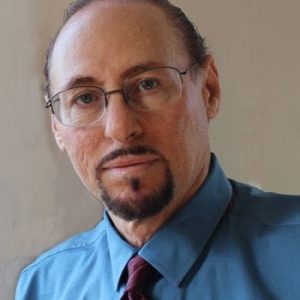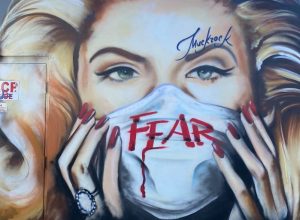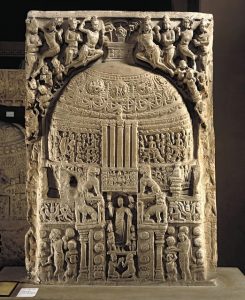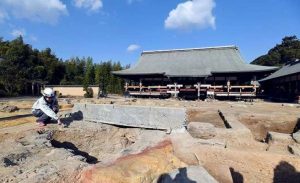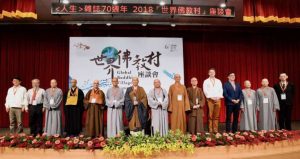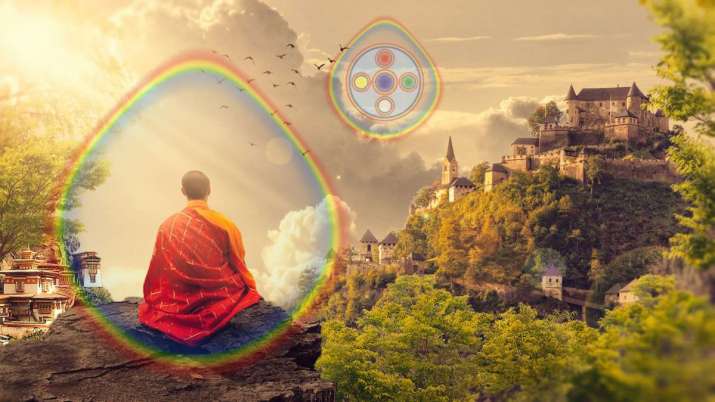
To create a Light Body is not magic, nor the result of wishful thinking. It is science—transformational science. A new embodiment made of quarks and photons does not arise without cause, nor without the interaction of many moving parts. Like everything else in our manifest world, the process follows specific steps and stages. Just like a plant, it requires the equivalent of the right soil, moisture, atmosphere, solar energy, temperature, and much else. There must also be a seed in the first place, a lineage stretching back to ancient primal forests. But simple DNA is not enough, for the forces that create the actual shape of our liver, legs, arms, or that of a leaf, are unknown to contemporary science. All growth and development occurs in spirals, in geometric forms whose mathematical formula are written in the ether.
The morphogenic fields of which English author Alfred Rupert Sheldrake speaks are also the stuff of the visionary, the mystic, the meditating tantric, the illuminated yogi. An energetic scaffold already exists for living things, for the growing plant, the budding embryo. But in the case of the fully formed human being, trying to form a secondary body, a new spiritual embodiment, there is nothing ready-to-wear. The Light Body structure is present only as a potential, an incomplete outline waiting to be colored in. The fascial sheaths, primo vascular system, cell microtubules, and stabilized fourth state water are our latticework. And the whizzing universe of photons and electromagnetic forces within us are the stuff to be molded into a body of rainbows. These are the templates, as well as the raw material that will become “enlightened.” For, as we know, in some cases the entire body becomes nothing other than luminosity, while others leave a form shrunken down to a miniature version of its previous bulk.
Energy economy
For this creation, we need plentiful raw materials. But the daily allotment of energy we produce to maintain our existence is simply not enough. Some of the required subtle substances are not produced at all by the average person. Others, we make in quantities that are only enough for repair, cellular detoxification, and the millions of mundane operations the organism requires. Sacred traditions, Vajrayana Buddhism primary among them, are intensely involved with helping the aspirant create those special materials in adequate amounts. This process is not child’s play and is the underlying reason why students go into isolated retreat for prolonged periods. Normal life depletes energy. When it comes to our vitality, usually whatever we make, we spend. An enormous amount is also wasted with meaningless talk, scattered attention, ceaseless circular thoughts, and futile activity. While the renunciant may be fed up with the banality of life, this is a simple rejection of society and shunning of ordinary activity. It is about efficiency, energy preservation, and being able to retain the precious substances that come from intense, focused practice. However, raw materials do not a house make. We had better know how to build—and especially in what order.
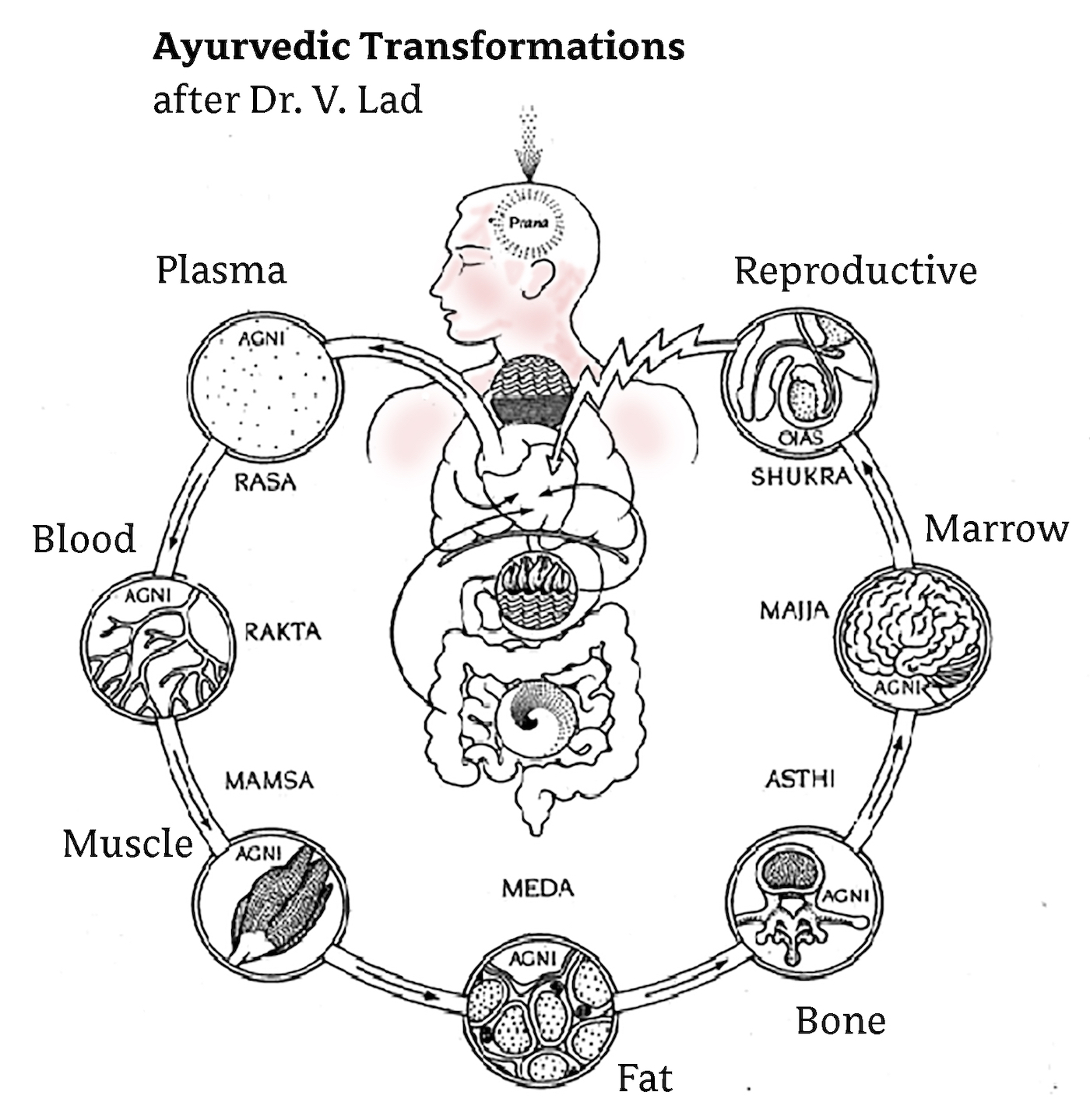
Stages of transformation
Knowing the working details of our energetic transformation is intellectually fascinating, but it is also highly practical. Understanding which levers to pull, what kind of energy we need, and how to fill in the missing pieces is the essence of tantric practice. But where to look for this information, this hidden manual of step-by-step biological transfiguration? As a spiritual practitioner, it is best to follow one tradition and follow it to its end. But if we want an in-depth understanding, it behooves us to look at the meanings contained within many different traditions, existing in different times and places. Every bona fide, well-established lineage holds substantial secrets that others do not. This cross-cultural investigation can only reinvigorate and strengthen our chosen path.
Tantric stages
Vajrayana literature is extremely rich in its description of the anatomy of the subtle body. The branch channels of the various chakras are cataloged and their functions outlined, such as the 64 sub-channels or “petals” of the pelvic chakra. Each has a visual syllable, a sound, and a specific function, described in both Vajrayana and ancient Shaivite texts. Such sounds are recited or folded into mantras for developing and maturing the luminous body. The energies and winds that move within the channels (tsa or nadi) are also laid out clearly. Yet there is very little information about the actual stages of going from a physical form to a light-based body. The exception concerns our old friends the five elements. It is only here that we see a sequential transformation, and then it is only at death. In the process of dying, the denser, coarser elements dissolve into the lighter, more refined. We see earth melt into water, water into fire, fire into air, and air into space. Space will ultimately merge with pure consciousness. This same sequence happens in a temporary way each night when we sleep, as our consciousness separates from the physical form. Or when we move our energies from the side channels into the central channel (uma) through various tantric meditations. But this elemental dissolution is not spoken of as the mechanism by which a Rainbow Body is achieved. And so we must glean clues from other traditions on how this proceeds.
Indian roots
We can start on familiar ground, in the knowledge of Buddhist Vajrayana, Ayurveda, and Hindu tantra. In Western physiology, we know that our digestion breaks food down into its component parts and then recombines these to form flesh, blood, nerve tissue, and the rest. We produce energy in our cells to do work, generating thermal, electrical, and photonic energy along the way. But in the Eastern concept, going back to the ancient Indian Vedas (1200 BCE) and Buddhist Abhidharma (300 BCE), there is the idea of progressive refinement, of producing ever more rarefied levels of substance. In both ancient and modern texts, a seven-step transformation cycle is described. Each phase or dhatu is represented by a particular body tissue, which then transforms into the next. Roughly translated into English these are: plasma, blood, muscle, fat, bone, marrow, and regenerative fluids. A final eighth stage is primal vitality or healing intelligence (ojas). This is mirrored in the Tibetan medical system, itself largely derived from Indian Ayurveda, but with a Chinese and local medicinal contribution. But one bodily organ turning into another makes no biological sense. Like the ancient Greeks who turned the five formative elemental forces into four liquid humors sloshing around inside the body, Ayurveda falls into a materialist trap. In fact, the sequence is actually describing an energetic shift. What is striking is that there is an octave of substances which corresponds to our traditional Western (and Eastern) system of musical notes. It is also echoed in the seven visible colors of the spectrum (although, in fact, there are infinite gradations, limited only by our vision). This shows up again in certain Indian and Tibetan seven-chakra systems. It also relates to the seven planets of ancient India, China, and Greece, which were understood as a hierarchy of energetic forces, not spinning globes.
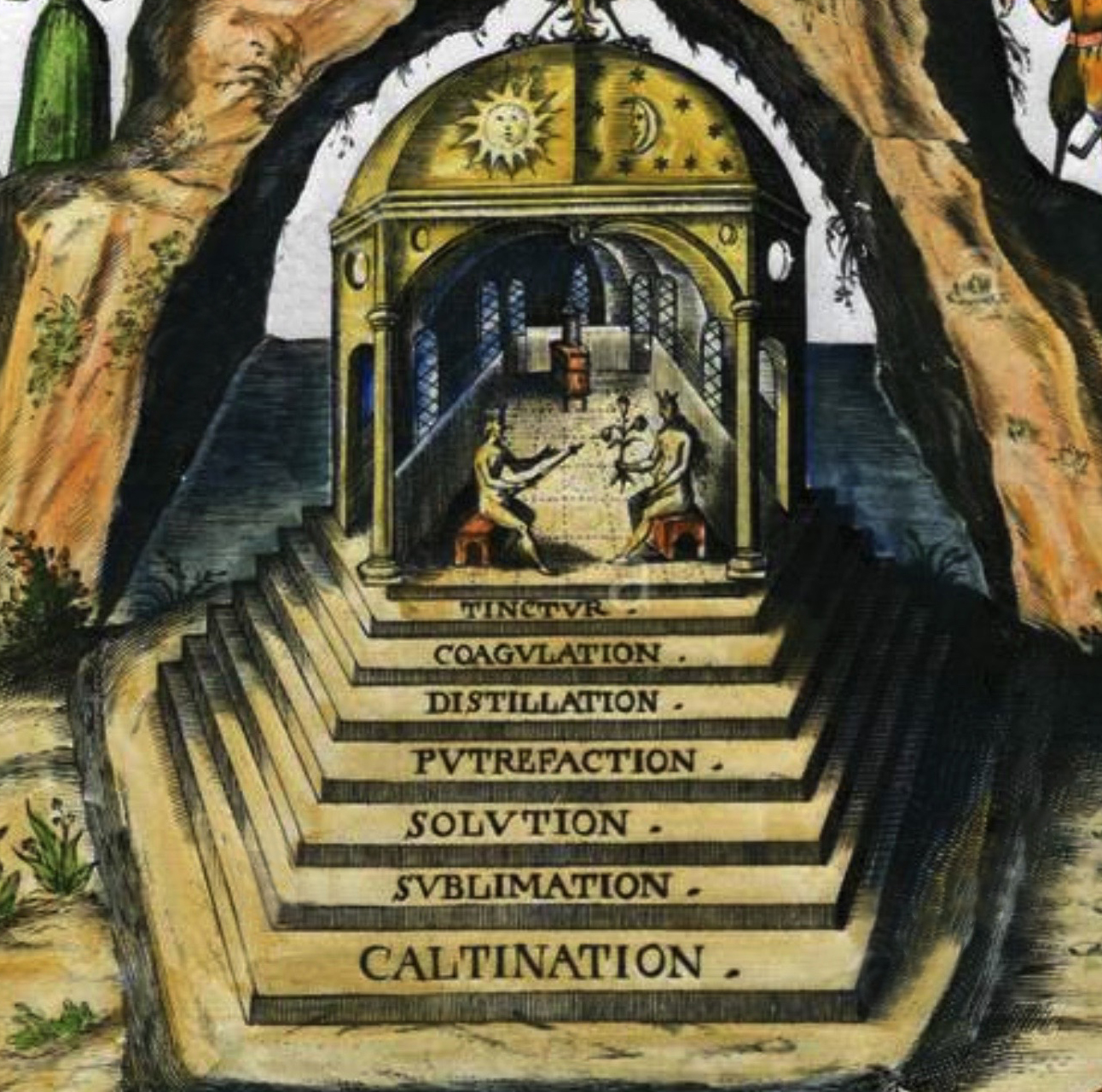
Daoist transformation
The Chinese system of inner alchemy or neidan is an advanced level of Daoist thought that brings us an embarrassment of riches. Here lie some of the most extensive—and possibly the oldest—systems of bioenergy anatomy, function, and practice. Inner alchemy encompasses a vast array of lineages and methods geared toward creating an immortal Light Body or sacred embryo (shengtai). The stages, phases, levels, and subsets of this process are intricate and overwhelming, defying a simple overview. However, at its core, Daoist alchemy follows a familiar pattern. Our most physical substances (jing) are transformed into subtle energy (qi), which moves into spiritual or mind energy (shen), then into emptiness, and finally into the Dao itself. These same ideas are echoed in traditional Chinese medicine and in Qigong and Medical Qigong. Neigong and neidan are the epitome of these approaches, being analogous to the inner tantras of the Hindu and Tibetan traditions. Until recently, the lineages and methods of these approaches were extremely secret. Only in recent decades have they become available to the avid Western seeker.
Alchemical connections
Centuries and worlds away, Western alchemy thrived all over Europe over 700 years ago. Transforming the base metal of our being into the purest immortal gold, the alchemist creates a homunculus, a spiritual form within the crucible of the material body. This is identical to the Asian Light Body traditions from whence this knowledge came. But while its roots are Egyptian (al-kemi), Indian, and Arabic (by way of ancient Greece), by the time of its full blossoming it was couched in a hidden language of arcane symbolism. The Indian tantrics used a similar kind of “twilight language” in order to hide the nature of their culturally transgressive activity from the religious power structures. The alchemists were certainly in similar danger of persecution from the Christian authorities, and the whole idea of making material gold out of lead was a clever smokescreen for the real work of creating the inner golden child. What strikes us again is the seven-stages of transformation at the core of the alchemical process. Studying the obscure symbols of the phases of calcination, dissolution, separation, conjugation, fermentation, distillation, and coagulation offers a veiled view into the same stair-step path toward full illumination as we find elsewhere.
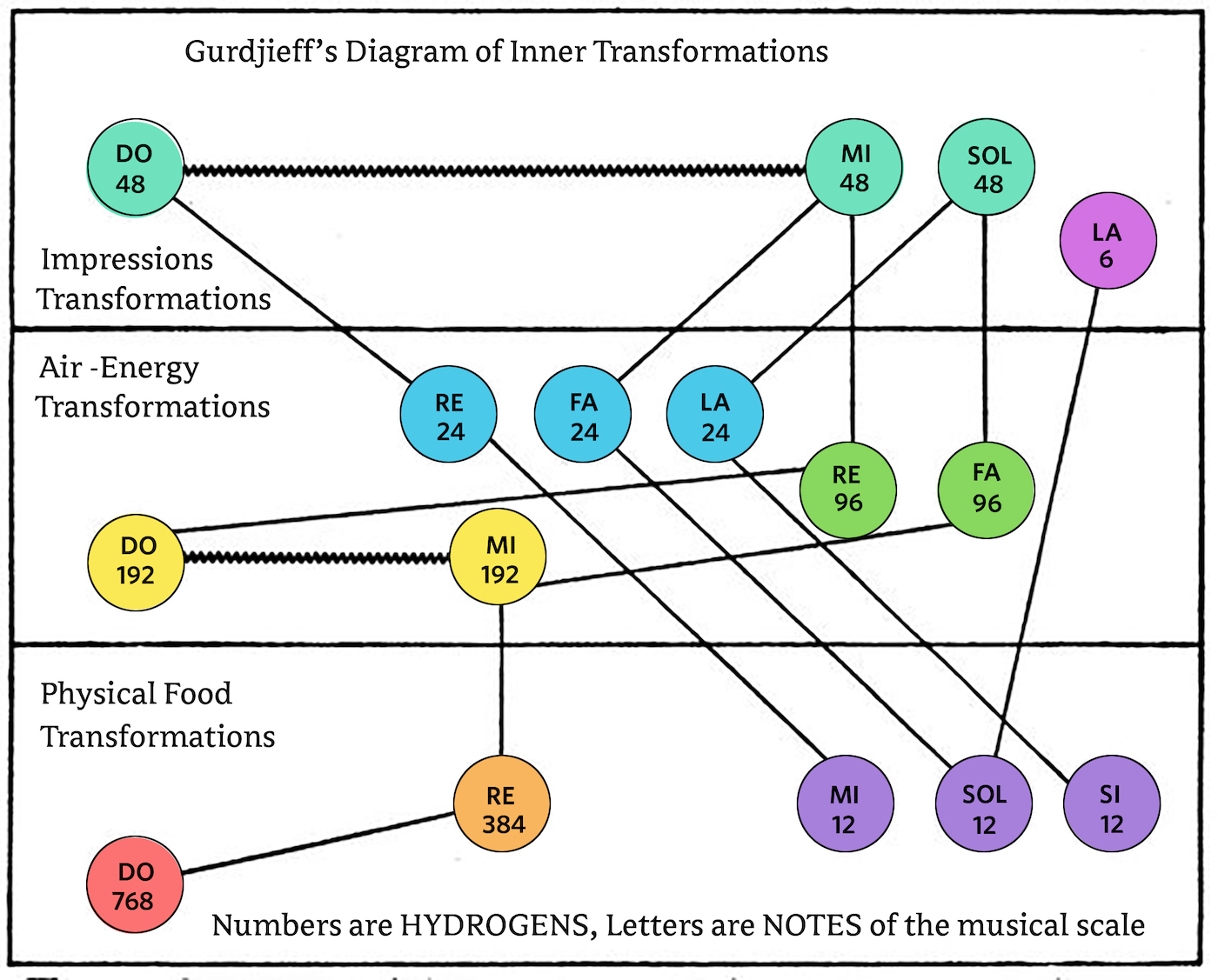
Gurdjieffian transformation
In the modern era, a detailed system of transformation comes to us through the system of the great mystic G. I. Gurdjieff. Variously identified with esoteric Christianity, Sufism, and Gnosticism, this Fourth Way school provides a detailed schema of how our three kinds of nourishment—food, air, and mental impressions—interact to generate ever more subtle energies. The Law of Octaves is portrayed in hydrogen diagrams that show what happens in the normal course of living, and how the entire process can shift when we engage in the right spiritual work. Demonstrating how to change from having just enough energy for life, to a transformative process where rarefied energetic “substances” are created, it echoes the hierarchical transformation of Chinese, Indian, Tibetan, and other traditions. In the Gurdjieffian path, the result is two “higher being bodies,” as we move from either a mental, emotional, or physical-centered type to a fully integrated human being. The diagram below shows the series of hydrogens that occur in a human body—seven normally, or eight if we are on a transformative path.
Musical scales
There are many other correlations that could be made in terms of sacred music and inner change. But unraveling the complex musical scales and mathematics of ancient Egyptian, Indian, Chinese, Islamic, and other traditional musical systems is far beyond our discussion or my expertise. However, the familiar Pythagorean octave (without discussing tunings or temperament) is a useful standard and an essential part of the mystical tradition of that ancient Greek master. The seven-part octave (eight if we arrive at the next beginning) perfectly expresses the movement from a lower vibration to a higher one—literally. This is more than just a theoretical scheme. This pattern of inner musical ascension is the basis of healing and transforming music, mantra, and seed syllables in traditions across every epoch.
A comparison of the seven stages as described by various lineages is shown in the table below:
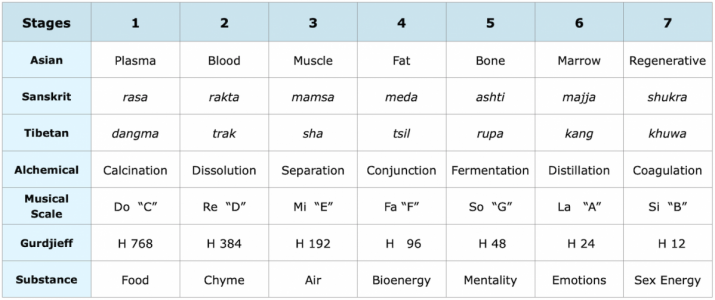
The Way of Light
In looking at the spiritual paths of very distinct cultures, surprisingly similar patterns emerge. Although usually hidden from superficial view, the magnificent path of the Light Body emerges as the center of the world’s great spiritual traditions. By its very nature, growing this interior radiant form progresses according to well-trodden stages. And it may be true that the entire natural world follows a similar vibrational octave in order to grow and reproduce. Understanding where we are in this process would be tremendously useful—even crucial—during inner development. But it also highlights another important spiritual truth. Even with a knowledge of spiritual sequence, it is difficult to impossible to see our own precise stumbling block or where our next inner opportunity lies. For that, an insightful and highly developed guru, a spiritual friend, is an essential ingredient. Such a one may be able to coax us, orally, silently, secretly, openly, or with any number of skillful means, to keep on track and jump to the next stage of our journey towards effulgence. Voyaging in the wilderness of our own mind, sailing within the oceans of our stormy karma, requires an accurate map—but also a skilled guide who knows well the territory.
While the octave sequence is not discussed in every tradition, it is certainly folded into the Vajrayana practices of deity meditation, mantra, visualization, and tsa-lung—inner energy manipulations. These practices generate spiritual energies that fuel a conflagration that will burn away our physicality, leaving only the body of energy. That fire begins with enthusiasm and continues through unwavering commitment and diligence.
References
Baker, Ian. 2019. Tibetan Yoga: Principles and Practices. Rochester, VT: Inner Traditions.
Jinpa, Thupten. 2018. Science and Philosophy in the Indian Buddhist Classics. Volume 1: The Physical World. New York City. Simon & Schuster.
Ouspensky, P. 1949. In Search of the Miraculous: Fragments of an Unknown Teaching. New York City: Harcourt Brace.
Plummer, Tony. 2013. The Law of Vibration. Petersfield: Harriman House.
Roob, Alexander, 2001. Alchemy & Mysticism. Cologne: Taschen.
Wallis, Christopher. Tantra Illuminated: The Philosophy, History and Practice of a Timeless Tradition. San Rafael: Mattamayūra Press.
Yangöngpa, Gyalwa (trans. E. Guarisco). 2015. The Secret Map of the Body: Visions of the Human Energy Structure. Arcidosso: Shangshung Publications.
See more




